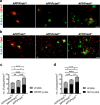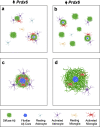Peroxiredoxin 6 mediates protective function of astrocytes in Aβ proteostasis
- PMID: 32907613
- PMCID: PMC7487614
- DOI: 10.1186/s13024-020-00401-8
Peroxiredoxin 6 mediates protective function of astrocytes in Aβ proteostasis
Abstract
Background: Disruption of β-amyloid (Aβ) homeostasis is the initial culprit in Alzheimer's disease (AD) pathogenesis. Astrocytes respond to emerging Aβ plaques by altering their phenotype and function, yet molecular mechanisms governing astrocytic response and their precise role in countering Aβ deposition remain ill-defined. Peroxiredoxin (PRDX) 6 is an enzymatic protein with independent glutathione peroxidase (Gpx) and phospholipase A2 (PLA2) activities involved in repair of oxidatively damaged cell membrane lipids and cellular signaling. In the CNS, PRDX6 is uniquely expressed by astrocytes and its exact function remains unexplored.
Methods: APPswe/PS1dE9 AD transgenic mice were once crossed to mice overexpressing wild-type Prdx6 allele or to Prdx6 knock out mice. Aβ pathology and associated neuritic degeneration were assessed in mice aged 10 months. Laser scanning confocal microscopy was used to characterize Aβ plaque morphology and activation of plaque-associated astrocytes and microglia. Effect of Prdx6 gene dose on plaque seeding was assessed in mice aged six months.
Results: We show that hemizygous knock in of the overexpressing Prdx6 transgene in APPswe/PS1dE9 AD transgenic mice promotes selective enticement of astrocytes to Aβ plaques and penetration of plaques by astrocytic processes along with increased number and phagocytic activation of periplaque microglia. This effects suppression of nascent plaque seeding and remodeling of mature plaques consequently curtailing brain Aβ load and Aβ-associated neuritic degeneration. Conversely, Prdx6 haplodeficiency attenuates astro- and microglia activation around Aβ plaques promoting Aβ deposition and neuritic degeneration.
Conclusions: We identify here PRDX6 as an important factor regulating response of astrocytes toward Aβ plaques. Demonstration that phagocytic activation of periplaque microglia vary directly with astrocytic PRDX6 expression level implies previously unappreciated astrocyte-guided microglia effect in Aβ proteostasis. Our showing that upregulation of PRDX6 attenuates Aβ pathology may be of therapeutic relevance for AD.
Keywords: Alzheimer’s disease; Astrocytes; Microglia; Neurodegeneration; Peroxiredoxin 6; Plaque seeding; Proteostasis; β-Amyloid plaques.
Conflict of interest statement
The authors declare no competing interests.
Figures










Similar articles
-
Acceleration of the development of Alzheimer's disease in amyloid beta-infused peroxiredoxin 6 overexpression transgenic mice.Mol Neurobiol. 2013 Dec;48(3):941-51. doi: 10.1007/s12035-013-8479-6. Epub 2013 Jun 15. Mol Neurobiol. 2013. PMID: 23771816
-
Astrocytic LRP1 Mediates Brain Aβ Clearance and Impacts Amyloid Deposition.J Neurosci. 2017 Apr 12;37(15):4023-4031. doi: 10.1523/JNEUROSCI.3442-16.2017. Epub 2017 Mar 8. J Neurosci. 2017. PMID: 28275161 Free PMC article.
-
Preferential clustering of microglia and astrocytes around neuritic plaques during progression of Alzheimer's disease neuropathological changes.J Neurochem. 2025 Jan;169(1):e16275. doi: 10.1111/jnc.16275. J Neurochem. 2025. PMID: 39655787 Free PMC article.
-
Neuritic Plaques - Gateways to Understanding Alzheimer's Disease.Mol Neurobiol. 2024 May;61(5):2808-2821. doi: 10.1007/s12035-023-03736-7. Epub 2023 Nov 8. Mol Neurobiol. 2024. PMID: 37940777 Free PMC article. Review.
-
The role of activated astrocytes and of the neurotrophic cytokine S100B in the pathogenesis of Alzheimer's disease.Neurobiol Aging. 2001 Nov-Dec;22(6):915-22. doi: 10.1016/s0197-4580(01)00293-7. Neurobiol Aging. 2001. PMID: 11754999 Review.
Cited by
-
Apolipoprotein E4 Effects a Distinct Transcriptomic Profile and Dendritic Arbor Characteristics in Hippocampal Neurons Cultured in vitro.Front Aging Neurosci. 2022 Apr 29;14:845291. doi: 10.3389/fnagi.2022.845291. eCollection 2022. Front Aging Neurosci. 2022. PMID: 35572125 Free PMC article.
-
PRDX6-iPLA2 aggravates neuroinflammation after ischemic stroke via regulating astrocytes-induced M1 microglia.Cell Commun Signal. 2024 Jan 29;22(1):76. doi: 10.1186/s12964-024-01476-2. Cell Commun Signal. 2024. PMID: 38287382 Free PMC article.
-
Behavioral and Synaptic Phenotypes of Female Prdx6-/- Mice.Antioxidants (Basel). 2022 Jun 19;11(6):1201. doi: 10.3390/antiox11061201. Antioxidants (Basel). 2022. PMID: 35740098 Free PMC article.
-
PRDX6 alleviated heart failure by inhibiting doxorubicin-induced ferroptosis through the JAK2/STAT1 pathway inactivation.In Vitro Cell Dev Biol Anim. 2024 Apr;60(4):354-364. doi: 10.1007/s11626-024-00889-0. Epub 2024 Mar 26. In Vitro Cell Dev Biol Anim. 2024. PMID: 38530594
-
Unveiling the Significance of Peroxiredoxin 6 in Central Nervous System Disorders.Antioxidants (Basel). 2024 Apr 10;13(4):449. doi: 10.3390/antiox13040449. Antioxidants (Basel). 2024. PMID: 38671897 Free PMC article. Review.
References
-
- Ulland TK, Colonna M. TREM2 - a key player in microglial biology and Alzheimer disease. Nat Rev Neurol. 2018;14:667–675. - PubMed
Publication types
MeSH terms
Substances
Grants and funding
LinkOut - more resources
Full Text Sources
Molecular Biology Databases
Miscellaneous

